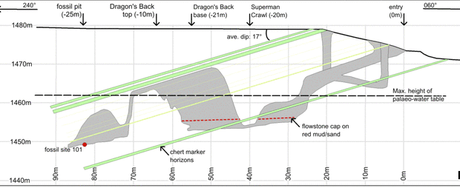
Scientists recently announced the discovery of Homo naledi. This key fossil sheds light on the period ~2 million years ago when our ancestors were evolving into something recognisably human. Or at least, that's what the pesky evilutionists would have you believe. Fortunately for the creationists the Institute for Creation Research has come up with a Biblical explanation for these fossils. Unfortunately for them its completely falsified by the original research into these fossils.
The original research they claim supports their Biblical explanation.
Their new hypothesis - which I discussed last week - is that Homo naledi is actually two different species merged together. This week they go into more detail as to how these fossils all got muddled together. Their answer: flash floods.
It is possible that flash-flooding of the larger chamber drowned the humans and animals taking refuge in the cave and transported their remains to the back of the cave system. Whether or not the ape-like bones were transported at the same time as the humans is unclear since subsequent flooding may have mixed them around
Now, whenever creationists normally bring up floods there is one rather significant flood they're talking about: Noah's. However, that's not the case here. Rather, it was a localised flood caused by meltwater at the end of the ice age.
This may have occurred during the beginning of the post-Flood period, and possibly during the Ice Age, when water levels and climate fluctuations would have been more dramatic and sporadic. The Bible indicates this took place just a few thousand years ago.
The first part of their hypothesis - that these represent the muddled bones of two species - is completely contradicted by the fossils themselves. As I mentioned in the last post on the topic (go back up and click on that link if you'd like to find out more).
And in a surprise twist, it turns out that this part of their hypothesis is completely falsified by the research as well. Even though they claim support from the original paper on the subject.
In a technical article published in eLife, Dirks and his colleagues described sedimentary evidence in the cave floor that suggests periods of higher water flow rates in the cave
This seems to be where they're getting the evidence for their explanation from. However, the water flowing into the cave Dirks et al. are referring to is very slow and low energy. Almost stagnant, certainly nothing that could have transported remains into the cave. In fact, Dirks explicilty notes the lack of evidence for water transporting the bones into the cave. From the paper:
The matrix sediments surrounding the fossils do not present evidence for sedimentation processes that involved significant water action . . . Likewise, the assemblage presents no evidence of fluvial modifications such as abrasion patterns caused by the movement of bone in water . . . The cave has been inundated in the past by rising water tables, but there is no evidence within the Dinaledi Chamber of depositional processes that involved high-energy transport mechanisms capable of transporting the large hominin bones . . . Thus, the accumulation of the hominin remains in the chamber does not fit the pattern of a flood or fluvial event
So I'm not really sure I can add much to that. The paper the ICR claims to have read and claims supports their view explicitly says they don't have a leg to stand on. Yet they try and stand on it anyway. All it would take is for a curious creationist to click on the original research - which is freely available - to find out just how wrong the ICR are.
I would like to speculate as to how they'd react to such a finding. However, I doubt many - if any - creationists are going to bother clicking through to find out this contradiction for themselves.
And now I'm sad.

